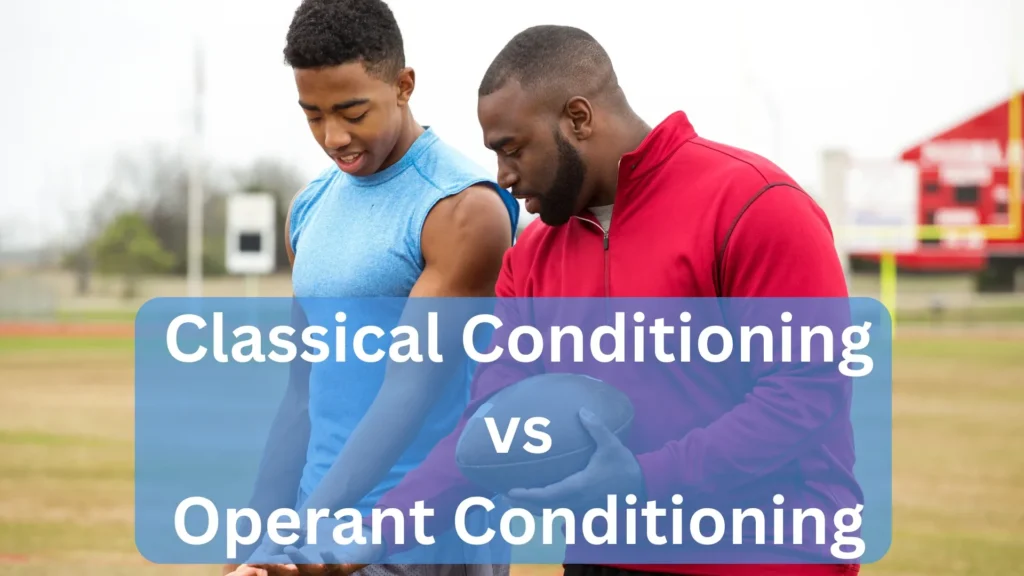
Today we’re talking about classical conditioning vs operant conditioning and more importantly which one will help you win!
What is Conditioning?
When we talk about classical conditioning vs operant conditioning in sports, we’re diving into how your brain and body can learn and adapt to better your performance.
This stuff isn’t just for class—it’s how you train to become your best on the field or court.
Conditioning, in the realm of sports psychology, is about training your mind and body to react in specific ways to specific situations.
It’s like programming yourself to be quicker, smarter, and tougher on the field.
But it’s more than just physical drills.
It’s about creating mental links and reflexes that you can count on during critical moments in a game.
This isn’t just for professional athletes either.
Whether you’re aiming to crush your next local 10K or looking to nail that free throw in a community basketball game, conditioning is key.
It’s about repeatedly exposing yourself to certain stimuli (like a coach’s whistle or the buzz before a race) until your body and mind respond almost automatically.
In sports, this could mean training yourself to stay calm and focused when you hear the crowd roar or to switch into high gear when you see certain cues from your opponents.
By fine-tuning these responses through various conditioning techniques, you’re not just practicing the sport.
You’re mastering how to stay in control under pressure, which is crucial for any athlete aiming for the top.
How is Conditioning Helping Me in Sports?
Conditioning is your secret weapon in sports.
It tweaks your reactions, hones your instincts, and solidifies your skills through repetition and rewards.
Ever notice how sometimes you just react without thinking?
That’s conditioning at work!
Conditioning is your backstage pass to becoming a more intuitive athlete.
It streamlines your reactions, making them faster and more efficient, so you can focus on strategy rather than on basic responses.
When you’re well-conditioned, your body knows what to do even before your conscious mind catches up.
For instance, through conditioning, a basketball player can perfect their shot so that during a high-pressure game moment, the mechanics of shooting are automatic.
Their mind is free to read the defense or spot an open teammate.
This automaticity is a direct result of meticulous, repetitive training and mental conditioning.
Moreover, conditioning also enhances endurance, both mental and physical.
It helps athletes endure long sessions or late stages of a game when fatigue sets in.
With conditioning, you’re not just training your muscles to last longer.
You’re also training your mind to persevere when every part of you screams for a break.
Furthermore, conditioning can help prevent injuries.
By conditioning your body through specific exercises, you strengthen the muscles and joints needed most in your sport, reducing the risk of injury during unplanned, quick movements.
It’s about building a resilient body that can take the impacts and demands of your sport without buckling under the pressure.
All in all, conditioning equips you with the mental and physical toughness needed to face any challenge in sports.
It’s about more than just getting through the game. It’s about dominating it from start to finish.
What is Classical Conditioning?
Classical conditioning is all about associations.
Think Pavlov and his dogs.
In sports, it could be as simple as associating a starter’s whistle with the surge of adrenaline you need to start a race.
This type of conditioning wires your brain to expect and react, setting you up for a quick launch.
Classical conditioning is a fundamental learning process where you learn to connect a neutral stimulus with a significant one, creating a naturally occurring response.
For athletes, this can be particularly impactful!
It means training your nervous system to associate non-threatening cues (like the sound of a starting buzzer) with automatic physiological responses (like an adrenaline rush).
In sports, this type of conditioning can be leveraged to enhance performance by creating strong, reliable associations.
For example, a sprinter might train to start their explosive sprint the moment they hear the starter gun.
This is not just about hearing the sound.
It’s about triggering the whole body to react instinctively and immediately.
Additionally, classical conditioning can help manage pre-game anxiety or nerves.
Athletes can condition themselves to feel relaxed and confident in response to cues that might normally trigger nervousness.
For instance, entering a packed stadium becomes a cue for feeling energized rather than anxious.
Another layer to this is the conditioning of emotional responses.
Athletes can be trained to associate challenging parts of their sport with positive emotions.
For example, a long-distance runner might link the fatigue felt in the later stages of a race with the thrill of the challenge.
Transforming pain into a motivational boost rather than a deterrent.
Thus, classical conditioning isn’t just about physical responses.
It’s also about conditioning emotions and mental states to work in favor of the athlete, turning potential stressors into triggers for positive, performance-enhancing reactions.
What is Operant Conditioning?
Operant conditioning deals with rewards and consequences.
It’s about learning from what happens after you act.
Hit a three-pointer and get cheered?
That’s operant conditioning reinforcement you to take that shot again.
It’s super useful for fine-tuning strategies and techniques.
Operant conditioning is a strategy based on the consequences of an action, reinforcing what works and discarding what doesn’t.
This approach is especially valuable in sports, where the focus is on improving specific behaviors to optimize performance.
It’s about learning from the outcome of each action and adjusting accordingly.
In a sports context, operant conditioning can involve positive reinforcement.
Such as praise from a coach or applause from spectators, which encourages the repetition of a successful play or technique.
Alternatively, negative reinforcement can also be employed. Where an undesirable outcome, like the discomfort of additional drills or the consequence of losing a point, motivates the athlete to change their behavior.
Moreover, operant conditioning can be tailored to individual athletes to focus on their unique needs.
For instance, a coach might use video replays as immediate feedback for a tennis player, showing them what they did right to earn points and what they did wrong that cost them.
This direct and specific feedback helps athletes make quicker adjustments and internalize optimal behaviours.
Punishment, though less frequently used because it can sometimes lead to anxiety or decreased motivation, is another aspect of operant conditioning.
It involves introducing an unfavourable outcome following an undesirable behaviour, discouraging that behaviour in the future.
Overall, operant conditioning is about making learning a dynamic process.
It involves a continuous loop of action, feedback, and adjustment, helping athletes refine their skills and strategies in real time.
And making it a critical component of sports training programs.

Which One is More Helpful in Sports and High Performance?
So, in the showdown of classical conditioning vs operant conditioning, which is the champ?
Both have their place on the podium.
Classical conditioning gets you off the blocks faster, helps manage nerves, and automates your responses.
Operant conditioning, though, shapes much of your strategic thinking and skill refinement through feedback.
In high-stakes games, the edge often goes to operant conditioning.
It’s about being adaptive and learning from each play or performance.
In the debate of classical conditioning vs operant conditioning, it’s important to recognize that each serves unique roles in sports training. With their relevance depending on the situation and the specific goals of the athlete.
Classical conditioning is incredibly beneficial for developing automatic responses to specific stimuli.
For athletes in sports requiring quick starts or reactions—like sprinters, swimmers, or baseball players—classical conditioning can be a game-changer.
It automates responses to cues such as starting guns or pitch movements, allowing athletes to perform with lightning-fast reflexes that don’t require conscious thought.
On the other hand, operant conditioning shines in environments where improvement and adaptation are ongoing.
It’s particularly useful in sports where strategy and decision-making play crucial roles, such as in football, basketball, or chess.
Here, athletes benefit from learning through the consequences of their actions, allowing them to adapt their strategies based on success or failure.
This type of conditioning is critical for skills development, strategic adjustments, and fine-tuning techniques.
The effectiveness of classical conditioning vs operant conditioning also varies across different stages of an athlete’s career.
Novices can see significant benefits from operant conditioning as they are actively learning and internalizing the basics of the sport.
For advanced athletes, classical conditioning can be more beneficial to hone and automate those skills already learned to perfection.
In high-performance settings, a combination of both methods is often most effective.
This hybrid approach ensures that athletes develop both the automatic physiological responses necessary for peak performance and the cognitive flexibility to adapt and strategize under pressure.
Integrating both conditioning types in training programs allows athletes to react instinctively when needed while also refining their skills and strategies based on the outcomes of their performances.
Thus, neither classical conditioning nor operant conditioning alone is the ultimate answer.
Instead, their combined use tailored to the athlete’s specific needs and context usually yields the best results in sports and high performance.
Examples of How to Implement Conditioning in My Training
To harness both types of conditioning, mix it up.
When looking to leverage both classical and operant conditioning in sports training, here are practical ways to integrate these concepts to enhance your performance:
Classical Conditioning
- Pre-Performance Routines:
Create a consistent pre-game or pre-practice routine that involves specific sensory cues, like listening to a particular song, using specific scents, or wearing a particular gear.
These cues can trigger mental states conducive to high performance, such as calmness or aggression, depending on the needs of the sport.
- Start Signal Training:
For sports that begin with a signal (like track or swimming), repeatedly practice starting your motion at the exact moment a particular sound plays.
This builds a neural pathway that will trigger an automatic start response during competitions.
- Emotional Conditioning:
Pair challenging aspects of your training with positive reinforcement.
For example, if endurance is your goal, follow a grueling long-distance session with something you enjoy, like a favorite meal or social time with friends.
This can help create positive associations with tough workouts.
Operant Conditioning
- Feedback Loops:
Implement immediate feedback for specific actions.
Use technologies like video analysis for instant playback so you can see what’s working or not.
Adjust techniques in real time based on this feedback to reinforce good practices and correct errors.
- Reward Systems:
Set up a system of rewards for achieving specific performance goals, such as new personal bests or mastering a complex technique.
Rewards could range from new equipment to more leisure time, depending on what motivates you effectively.
- Consequence Management:
Introduce mild penalties for not meeting certain standards during practice, like extra drills or a temporary restriction from a favored piece of equipment.
This can increase the stakes during training, fostering a more disciplined approach.
Integrating Both Approaches
- Cue-Based Drills:
Combine the two by using a cue (classical conditioning) followed by a specific drill with immediate feedback (operant conditioning).
For instance, a whistle blow could initiate a drill where a basketball player must make a quick decision to pass or shoot, with immediate commentary from the coach.
- Mental Visualization:
Use visualization techniques where you imagine performing a task perfectly and pair this with a physical cue (like tapping your wrist).
This mental rehearsal can help solidify the physical and psychological elements of your performance.
- Progressive Difficulty:
Start with simpler tasks that can be easily mastered and rewarded, then gradually increase the complexity as you become more proficient.
This tiered approach helps build a solid foundation of skills that are then refined and expanded upon through further training.
By incorporating these examples into your training regimen, you can effectively use classical conditioning vs operant conditioning to enhance both your physical skills and mental acuity, leading to better performance in your sport.
Balancing Act: Mental and Physical Conditioning
Remember, it’s not just about physical training.
Mental conditioning plays a huge role, too.
Visualize success, and mentally rehearse your strategies.
This approach helps blend classical conditioning (visualization) with operant conditioning (mental adjustment based on imagined outcomes).
Achieving peak performance in sports isn’t just about physical prowess.
It’s equally about mental resilience!
Balancing mental and physical conditioning is crucial for athletes aiming to excel in both training and competition settings.

Strengthening Mental Resilience
Regular mindfulness practices can enhance concentration, reduce performance anxiety, and improve mental stamina.
Techniques like meditation or focused breathing exercises help train the brain to maintain attention and calmness under pressure.
Also use cognitive behavioral strategies. These involve recognizing negative thought patterns and actively changing them.
For instance, replacing thoughts like “I can’t do this” with “I can handle this challenge” during intense parts of training can condition the mind to handle stress and adversity better.
And don’t forget about psychological skills training (PST). This includes setting effective goals, enhancing imagery skills, and using self-talk to boost confidence and manage emotions.
These skills are crucial for maintaining mental clarity and motivation, especially during critical moments of competition.
Enhancing Physical Conditioning
Enhancing physical conditioning involves integrating training programs that address both the stamina and skill needed for the sport.
For example, mixing endurance exercises with specific drills ties physical conditioning directly to performance improvements.
It’s crucial to include recovery in your training regimen.
Proper recovery includes getting enough sleep, eating right, staying hydrated, and using active recovery methods like stretching or foam rolling.
This approach helps prevent injuries and keeps the body primed to perform and adapt.
Periodization is another key aspect, involving the systematic planning of athletic training to progressively cycle through different training focuses over a specific period.
This strategy helps maximize performance and minimize overtraining by avoiding plateaus and allowing athletes to physically and mentally adapt to changing training phases.
Integrating Mental and Physical Aspects
Integrating mental and physical aspects starts with using training scenarios that simulate the stress and pressure of actual competitions.
This helps athletes perform under the emotional and physical pressures they face in real settings.
Including team dynamics and communication exercises is crucial for team sports.
Practicing communication during physical strain, like drills or scrimmages, boosts a team’s effectiveness under pressure, improving overall performance.
Continuously learning about new physical conditioning techniques and mental strategies is also important.
Staying updated allows for the integration of innovative practices that enhance mental resilience and physical endurance.
Addressing both mental and physical elements lets athletes develop a comprehensive conditioning regime, enhancing their overall performance and equipping them to handle their sport’s challenges more effectively.
This holistic approach prepares them for the demands of competitive sports and supports long-term health and performance.
Conclusion
Both classical conditioning and operant conditioning offer valuable tools for any athlete.
By understanding and applying these concepts, you can sharpen your mind and body to react and adapt swiftly, pushing you towards victory.
Remember, it’s not just about hard work.
It’s about smart work!
Use classical conditioning vs operant conditioning to train effectively, responding automatically to some signals while adapting to others based on outcomes.
Remember, it’s not about choosing one over the other, but rather, how you can smartly integrate both to play your best game.
Mix and match techniques, find what works best for you, and keep tweaking as you grow.
If you’re looking to step up your game even more, check out the Success Stories Community.
Here, you’ll find tons of support from me, your go-to sports psychologist, and a bunch of folks who are just as pumped to get better as you are.
We’ve got all the resources to help you keep hitting those high-performance goals.
So, dive into the community, share your journey, learn from others, and grab the tools you need to shine.
Let’s make those wins happen together!



